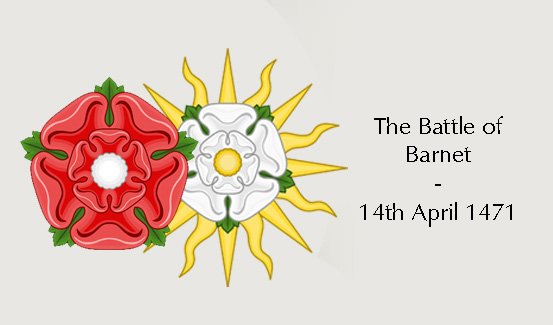The Battle of Barnet – 1471
The Battle of Barnet, which took place on 14th April 1471, was a significant battle during the Wars of the Roses, a series of civil wars that plagued England during the 15th century.
The battle was fought between the forces of the House of York, led by King Edward IV, and the forces of the House of Lancaster, led by Richard Neville, Earl of Warwick, also known as the “Kingmaker.” The Battle of Barnet was a decisive clash that resulted in a major victory for the Yorkists, with profound political, military, and social consequences that shaped the course of English history.
The Wars of the Roses were a series of conflicts between two rival branches of the royal Plantagenet dynasty in England – the House of York, symbolized by the white rose, and the House of Lancaster, symbolized by the red rose. These wars were characterized by shifting allegiances, power struggles, and battles for the control of the English crown. Edward IV, a Yorkist, had successfully taken the throne from Henry VI, a Lancastrian, in 1461 and had been ruling as King of England since then.
However, in 1470, a rebellion led by Richard Neville, Earl of Warwick, who had previously been a key supporter of Edward IV, turned against him and forced him to flee to Burgundy. Warwick then restored Henry VI to the throne, but the alliance between Warwick and the Lancastrians was short-lived, as Edward IV gathered support and returned to England in March 1471 to reclaim his throne. The stage was set for a decisive battle between the forces of Edward IV and Warwick.
The Battle of Barnet took place near the town of Barnet in Hertfordshire, England, on April 14, 1471. The battle started early in the morning with a thick fog, which affected the visibility and added an element of confusion to the proceedings. Both sides deployed their forces, with Edward IV leading the Yorkists and Warwick leading the Lancastrians.
The exact details of the battle are unclear, as the fog hindered the vision and communication among the troops. It is believed that Warwick’s forces, which were positioned on higher ground, initially had the advantage, as they were able to charge downhill and break through the Yorkist lines. However, the fog caused confusion among Warwick’s troops, and friendly fire may have occurred, resulting in chaos and disarray.
Edward IV, taking advantage of the situation, launched a counterattack with his reserves, which had been concealed behind a hedgerow. The Yorkist troops, led by Edward IV and his brother Richard, Duke of Gloucester (later Richard III), attacked from the rear, causing panic among the Lancastrians. Warwick’s forces were soon overwhelmed, and he was killed in the heat of battle, along with many of his key supporters. The Lancastrians fled the battlefield in disarray, leaving behind a decisive victory for the Yorkists.
The key commanders in the battle were:
-
Edward IV – King of England from 1461 to 1470, and again from 1471 until his death in 1483. He led the Yorkist forces and personally participated in the battle, providing strategic leadership and battlefield tactics.
-
Richard Neville, Earl of Warwick – Also known as Warwick the Kingmaker, he was a prominent nobleman and military commander who initially supported Edward IV but later turned against him. Warwick commanded the Lancastrian forces, positioned his troops on higher ground, and launched a successful charge downhill before being killed in battle.
-
Richard, Duke of Gloucester (Richard III) – Younger brother of Edward IV and later the last Plantagenet king of England, Richard III fought alongside his brother as one of the key commanders of the Yorkist forces. He led a successful counterattack and played a crucial role in turning the tide in favour of the Yorkists.
-
William Hastings – A loyal supporter of Edward IV, Hastings served as his Chamberlain and was a key advisor. He commanded a contingent of troops for the Yorkists and played a crucial role in the battle, providing leadership on the battlefield.
-
John de Vere, Earl of Oxford – A Lancastrian nobleman and military commander, Oxford played a significant role in the Battle of Barnet. He commanded a contingent of troops for the Lancastrians and led the vanguard charge downhill, initially breaking through the Yorkist lines and creating confusion among their ranks.
The Battle had several consequences:
-
Consolidation of Yorkist Power: The Battle of Barnet was a major victory for Edward IV and the Yorkists. It resulted in the defeat and death of Richard Neville, Earl of Warwick, a key Lancastrian supporter and military commander. With Warwick out of the picture, Edward IV was able to consolidate his power and strengthen his position as king, effectively eliminating one of the main threats to his reign. This victory further solidified the Yorkist claim to the throne and paved the way for Edward IV to continue his rule with more authority.
-
Lancastrian Faction Weakened: The defeat at Barnet significantly weakened the Lancastrian faction, which was led by Warwick and had been a formidable rival to the Yorkists. Warwick’s death in battle was a significant blow to the Lancastrians, as he was a skilled military commander and a key figure in their cause. The loss of his leadership and strategic prowess dealt a severe blow to the Lancastrian forces, leaving them in a weakened state and making it more difficult for them to continue their resistance against the Yorkists.
-
Political Repercussions: The Battle of Barnet had important political repercussions. With Warwick’s death, the Lancastrians lost a powerful ally who had been instrumental in forging alliances and negotiating political agreements. This loss weakened the Lancastrian cause and left them with internal divisions and struggles for leadership. On the other hand, Edward IV’s victory at Barnet consolidated his authority and allowed him to exercise greater control over the government and strengthen his position as king.
-
Impact on the Wars of the Roses: The Wars of the Roses were a series of civil wars fought between the rival factions of York and Lancaster for control of the English throne. The Battle of Barnet was a significant turning point in these wars, as it resulted in a decisive Yorkist victory and weakened the Lancastrians. It shifted the balance of power in favour of the Yorkists, who would go on to rule England until the Battle of Bosworth.
-
Personal Consequences: The Battle of Barnet had personal consequences for several key figures involved. The death of Warwick, the “Kingmaker,” in battle was a significant loss for the Lancastrians and left a power vacuum among their ranks. The outcome of the battle had a direct impact on the lives and fortunes of many individuals involved, reshaping the political landscape of England and solidifying the domination of the House of York for the following years.
-
Military Tactics and Strategies: The battle was characterized by a surprise dawn attack by the Lancastrians, who charged downhill and initially broke through the Yorkist lines. However, the Yorkists, under the leadership of Edward IV and Richard, Duke of Gloucester (later Richard III), effectively regrouped and launched a counterattack that turned the tide of the battle in their favour. The effective use of terrain, positioning of troops, and coordinated attacks played a crucial role in the outcome of the battle, highlighting the significance of military tactics and strategies in medieval warfare.
-
Human Cost: Like any battle, the Battle of Barnet had a significant human cost. The battle resulted in an estimated 11,000 casualties – 10,000 on the Lancastrian side.
READ MORE
The House of York during the Wars of the Roses (Article about the key figures in the House of York)
The House of Lancaster during the Wars of the Roses (Article about the key figures in the House of Lancaster)
LINKS
House of York Collection – (House of York themed merch from High Speed History)
Richard III Collection – (Richard III themed merch from High Speed History)
Tudor Collection – (Tudor themed merch from High Speed History)





1 Comment
Comments are closed.